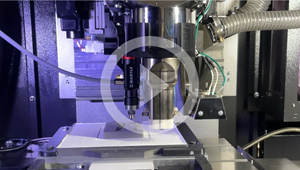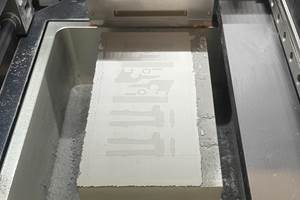Laser Consolidation -- One-Step Manufacturing of Metal Parts and Tools
Laser-based direct manufacturing process allows parts to be built directly from digital data using a wide variety of metallic powders.
Share
Read Next
In his 2005 state of the industry report, Terry Wohlers writes, "Rapid manufacturing is a vision of the future for many and a reality for a few ... The technique uses additive processes to deliver finished parts directly from digital data, which eliminates all tooling. Parts with complex shapes and features are delivered in less time and at a lower overall manufacturing cost."
Laser consolidation (LC) is a laser-based direct manufacturing process with promise to live up to that potential. Compared to traditional fabrication processes such as casting and machining, LC is a net-shape process that does not require tooling or secondary processing (except interfaces). Net-shape functional parts can be built directly from a wide variety of metallic powders, without molds or dies.
LC, developed at Canada's National Research Council's Integrated Manufacturing Technologies Institute (NRC-IMTI) and licensed to Accufusion, Inc. (London, ON), is particularly well suited for fabrication or repair of thin-walled titanium and superalloy parts with complex surfaces that are difficult or impossible to machine. LC-produced parts have excellent mechanical properties, dimensional accuracy, and surface finish. While smaller complex parts are best suited to the LC process, parts up to 1m x 1m x 1m can be accommodated. Applications include turbine engine components, aerospace structures and auto racing components.
The Process
LC forms complex structures layer by layer utilizing an Nd:YAG laser,
powder feeder, and CNC motion system. Starting from a CAD model, LC
combines proprietary software with the material properties/process
parameters database to determine the optimum parameters for controlling
the laser, powder feeder, and motion system.
A wide variety of commercially available materials can be processed, including stainless steels, tool steels, nickel and cobalt-based alloys and titanium. Processing parameters for other materials including aluminium are under development. Materials currently available include:
- 316 and 420 stainless steels
- Inconel-625and IN-738 superalloy
- CPM-9V tool steel
- Stellite 6 alloy
- Ti-6Al-4V titanium alloy
- H-13 tool steel
Parts produced using LC exhibit net-shape dimensional accuracy and surface finish, as well as excellent part strength and material properties. Mechanical properties are generally better than cast and comparable to wrought materials, and processed materials show excellent tensile and yield strength. Test results, including a comparison to other manufacturing processes. Fatigue properties of the LC parts were also found to be better than cast material.
According to Adri Coppens, Vice President of Accufusion, "The process has been validated through numerous collaborative projects with various industry leaders. There are currently five operating machines with thousands of hours of operation. LC can reduce costs, improve quality, facilitate rapid product development, and enable mass customization."
Laser consolidation has been used for the following projects and applications.
- Integrated boom and housing for remote manipulator arm--The boom and housing segments of the arm were integrated into one part using LC, resulting in optimized design and functionality through reduction in the number of parts, increased structural integrity and support for electronic circuit boards.
- Sonar shells for acoustic transducers--Complex sonar shells were made from IN-625 and Ti-6Al-4V for low-frequency sonar applications. LC was the only method capable of manufacturing the shells to the required specifications.
- Cutting dies--LC shows potential in the manufacture and repair of dies for cutting material such as cardboard, paper, labels, and other products. Cutting dies are currently manufactured by machining down a tool steel block and heat-treating. With LC, the dies can be manufactured by building up the tool steel cutting blade on a lower-cost steel substrate. In many cases, heat-treating is not required. The dies can be repaired when worn and the substrates reused for new dies.
- Repair of expensive parts--Laser consolidation is especially suitable for the repair of expensive components because of the precision of the process and the low heat input. Applications include turbine blades, impellers, and molds/dies.
- Features on existing parts--LC can be used to add complex features to components such as building airfoils on a turbine disc to form a blisk or adding local features to larger aero-structures.
Related Content
3D Printing Molds With Metal Paste: The Mantle Process Explained (Video)
Metal paste is the starting point for a process using 3D printing, CNC shaping and sintering to deliver precise H13 or P20 steel tooling for plastics injection molding. Peter Zelinski talks through the steps of the process in this video filmed with Mantle equipment.
Read MoreVideo: 5" Diameter Navy Artillery Rounds Made Through Robot Directed Energy Deposition (DED) Instead of Forging
Big Metal Additive conceives additive manufacturing production factory making hundreds of Navy projectile housings per day.
Read More3D Printed NASA Thrust Chamber Assembly Combines Two Metal Processes: The Cool Parts Show #71
Laser powder bed fusion and directed energy deposition combine for an integrated multimetal rocket propulsion system that will save cost and time for NASA. The Cool Parts Show visits NASA’s Marshall Space Flight Center.
Read MoreAM 101: What Is Binder Jetting? (Includes Video)
Binder jetting requires no support structures, is accurate and repeatable, and is said to eliminate dimensional distortion problems common in some high-heat 3D technologies. Here is a look at how binder jetting works and its benefits for additive manufacturing.
Read MoreRead Next
Alquist 3D Looks Toward a Carbon-Sequestering Future with 3D Printed Infrastructure
The Colorado startup aims to reduce the carbon footprint of new buildings, homes and city infrastructure with robotic 3D printing and a specialized geopolymer material.
Read MoreBike Manufacturer Uses Additive Manufacturing to Create Lighter, More Complex, Customized Parts
Titanium bike frame manufacturer Hanglun Technology mixes precision casting with 3D printing to create bikes that offer increased speed and reduced turbulence during long-distance rides, offering a smoother, faster and more efficient cycling experience.
Read MoreProfilometry-Based Indentation Plastometry (PIP) as an Alternative to Standard Tensile Testing
UK-based Plastometrex offers a benchtop testing device utilizing PIP to quickly and easily analyze the yield strength, tensile strength and uniform elongation of samples and even printed parts. The solution is particularly useful for additive manufacturing.
Read More




















